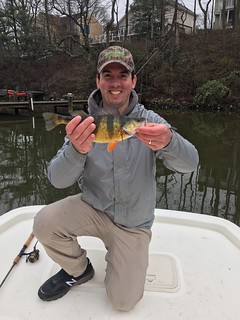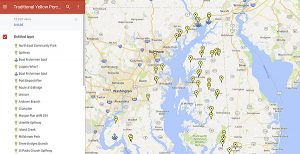The yellow perch spawning runs may peak in the next week and the bulk of the white perch runs will follow shortly, depending on water temperatures. Warm and sunny weather will move the action along; cold, cloudy days will hinder it. Many an angler has stopped by his favorite fishing hole to ask that classic question about yellow perch fishing, only to receive the equally classic answer, "you should have been here earlier." Hopefully some of the following tips will help.
Currently, water temperatures in many of the upper reaches of the tidal rivers are in the range of 43 to 48 degrees. The optimum spawning temperature range for yellow perch is 48 to 54 degrees; for white perch it's 59 to 60 degrees. The tidal waters on the western side of the bay typically will run a little warmer than the same latitude on the eastern side. At a low ebb tide the perch tend to sit it out in deeper holes and a flooding tide will push them further upstream toward their spawning habitat.
As with any species, the males are the first to arrive for the party and this past week male yellow perch have been the dominant catch in many areas. That is about to change. The minimum legal size for yellow perch is 9 inches and you are allowed to catch 10 per day. It takes about four years for a yellow perch to measure 9 inches or more, and males stop growing at 9.5 inches in length.

Matthew Blanchet enjoyed a fun day of catch-and-release fishing for yellow perch in the upper Magothy River. Photo courtesy of Matthew Blanchet
Fisheries biologist Paul Piavis was kind enough to send us a few observations on yellow perch populations this year: "There is a definite, strong 2014 and 2015 year-class presence this year, but it'll probably take another year or two to enter into the recreational fishery. They are strong enough that anglers should expect to have to cull through a lot of undersized fish, but bigger fish are out there. The 2011 year-class is still kickin' it."
Minnows hooked through the mouth with a shad dart or hook under a bobber or a two-hook bottom rig are good choices when the perch are holding in the deeper parts of the upper reaches of the tidal rivers. Casting a shad dart with a minnow or a piece of a minnow – or a scent-enhanced piece of felt on the hook – is also a great way to fish and cover areas when searching for that hole that contains the mother lode of yellow perch. Small, crappie-type curly-tail plastic jigs are popular and can also work well when live bait is scarce.
The upper bay region contains quite a few good places to fish for yellow perch, and the Susquehanna River is one of the first places to find them. Unfortunately, the Conowingo Dam is dumping a lot of water, and there is more on the way from Pennsylvania, causing turbulent and stained water conditions. The Northeast River offers a great place to fish for yellow perch and Northeast Community Park offers easy access and plenty of fish. The Bush River underneath the Route 40 Bridge is another popular spot to fish for yellow perch, as is the Magothy River.
Some white perch are being caught in the tidal rivers of the upper bay region as well as chain pickerel; fishing for channel catfish has been excellent.
In the middle bay region, the yellow perch fishing is on schedule in many of the region's tidal rivers. The yellow perch have made their way up the rivers to where they narrow down to widths of 30 yards or less. The white perch are a few miles downriver, but steadily moving upriver. For example, the upper Tuckahoe River in the Hillsboro area and the upper Choptank River near Goldsboro have been good places to catch yellow perch. Most of the white perch can be found in the Denton area on the Choptank River but they have been caught recently all the way up to Red Bridges in the Goldsboro area. A mix of chain pickerel, crappie and channel catfish are often in the mix.
http://www.tpfr.org
---
You received this message because you are subscribed to the Google Groups "Tidal Potomac Fly Rodders" group.
To unsubscribe from this group and stop receiving emails from it, send an email to tidal-potomac-fly-rodders+unsubscribe@googlegroups.com.
To post to this group, send email to tidal-potomac-fly-rodders@googlegroups.com.
To view this discussion on the web visit https://groups.google.com/d/msgid/tidal-potomac-fly-rodders/8a3936a6-5d50-46a5-81b5-11cf6eadbe5a%40googlegroups.com.
For more options, visit https://groups.google.com/d/optout.

No comments:
Post a Comment